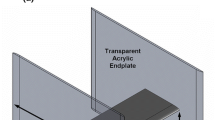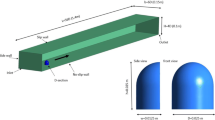Abstract
The wake produced by a bluff body driven through a steady recirculating flow is studied experimentally in a water facility using particle image velocimetry. The bluff body has a rectangular cross section of height, \(H\), and width, \(D\), such that the aspect ratio, AR = H/D, is equal to 3. The motion of the bluff body is uniform and rectilinear, and corresponds to a Reynolds number based on width, Re D = 9,600. The recirculating flow is confined within a hemicylindrical enclosure and is generated by planar jets emanating from slots of width, \(h\), such that \(Re_h=500\). Under these conditions, experiments are performed in a closed-loop facility that enables complete optical access to the near-wake. Velocity fields are obtained up to a distance of \(13D\) downstream of the moving body. Data include a selection of phase-averaged velocity fields representative of the wake for a baseline case (no recirculation) and an interaction case (with recirculation). Results indicate that the transient downwash flow typically observed in wakes behind finite bodies of small aspect ratio is significantly perturbed by the recirculating flow. The wake is displaced from the ground plane and exhibits a shorter recirculation zone downstream of the body. In summary, it was found that the interaction between a bluff body wake and a recirculating flow pattern alters profoundly the dynamics of the wake, which has implications on scalar transport in the wake.

















Similar content being viewed by others
References
Adaramola MS, Akinlade OG, Sumner D, Bergstrom DJ, Schenstead AJ (2006) Turbulent wake of a finite circular cylinder of small aspect ratio. J Fluid Struct 22(6–7):919–928
Afgan I, Moulinec C, Prosser R, Laurence D (2007) Large eddy simulation of turbulent flow for wall mounted cantilever cylinders of aspect ratio 6 to 10. Int J Heat Fluid Flow 28(4):561–574
Ayoub A, Karemcheti K (1982) An experiment on the flow past a finite circular cylinder at high subcritical and supercritical reynolds numbers. J Fluid Mech 118:1–26
Barnard RH (1996) Road vehicle aerodynamic design, an introduction. Addison-Wesley Longman, Boston
Bearman PW, Beer DD, Hamidy E, Harvey JK (1989) The effect of a moving floor on wind-tunnel simulation of road vehicles. SAE Paper 890368
Budwig R (1994) Refractive index matching methods for liquid flow investigations. Exp Fluids 17(5):350–355
Choi JI, Edwards JR (2008) Large eddy simulation and zonal modeling of human induced contaminant transport. Indoor Air 18(3):233–249
Craven BA, Settles GS (2006) A computational and experimental investigation of the human thermal plume. J Fluid Eng-T ASME 128(6):1251–1258
Doligalski TL, Smith CR, Walker JDA (1994) Vortex interactions with walls. Annu Rev Fluid Mech 26:573–616
Edge BA, Paterson EG, Settles GS (2005) Computational study of the wake and contaminant transport of a walking human. J Fluid Eng-T ASME 127(5):967–977
Farivar D (1981) Turbulent uniform flow around cylinders of finite length. AIAA J 19(3):275–281
Flynn MR, Eisner AD (2004) Verification and validation studies of the time averaged velocity field in the very near-wake of a finite elliptical cylinder. Fluid Dyn Res 34(4):273–288
Fröhlich J, Rodi W (2004) LES of the flow around a circular cylinder of finite height. Int J Heat Fluid Flow 25(3):537–548
Huber AH, Arya SP, Rajala SA, Borek JW (1991) Preliminary studies of video images of smoke dispersion in the near wake of a model building. Atmos Environ 25A(7):1199–1209
Kawamura T, Hiwada M, Hibino T, Mabuchi I, Kumada M (1984) Flow around a finite circular cylinder on a flat plate (cylinder height greater than turbulent boundary layer thickness). B JSME 27(232):2142–2151
Kolar V, Lyn DA, Rodi W (1997) Ensemble-averaged measurements in the turbulent near wake of two side-by-side square cylinders. J Fluid Mech 346:201–237
Krajnović S, Davidson L (2005) Influence of floor motions in wind tunnels on the aerodynamics of road vehicles. J Wind Eng Ind Aerodyn 93(9):677–696
Lajos T, Preszler L (1986) Effect of moving ground simulation on the flow past bus models. J Wind Eng Ind Aerodyn 22(2–3):271–277
Larsson L, Hammar L, Nilsson LU, Berndtsson A, Knutson K, Danielson H (1989) A study of ground simulation–correlation between wind tunnel and water-basin tests of a full-scale car. SAE Paper 890368
Leweke T, Williamson CHK (1998) Cooperative elliptic instability of a vortex pair. J Fluid Mech 360:85–119
Lin CH, Wu TT, Horstman RH, Lebbin PA, Hosni MH, Jones BW, Beck BT (2006) Comparison of large eddy simulation predictions with particle image velocimetry data for the airflow in a generic cabin model. HVAC&R Res 12(3C):935–951
Liou TM, Chen SH, Hwang PW (2002) Large eddy simulation of turbulent wake behind a square cylinder with a nearby wall. J Fluid Eng-T ASME 124(1):81–90
Liu Y, So RMC, Cui ZX (2005) A finite cantilevered cylinder in a cross-flow. J Fluid Struct 20(4):589–609
Martinuzzi R, Tropea C (1993) The flow around surface-mounted, prismatic obstacles placed in a fully developed channel flow. J Fluid Eng-T ASME 115(85):85–92
Mazumdar S, Chen Q (2008) Influence of cabin conditions on placement and response of contaminant detection sensors in a commercial aircraft. J Environ Monit 10(1):71–81
Mercker E, Wiedemann J (1990) Comparison of different ground simulation techniques for use in automotive wind tunnels. SAE Paper 900321
Moffat RJ (1988) Describing the uncertainties in experimental results. Exp Therm Fluid Sci 1:3–17
Müller RHG, Scherer T, Rötger T, Schaumann O, Markwart M (1997) Large body aircraft cabin A/C flow measurement by helium bubble tracking. J Flow Vis Image Proc 4:295–306
Nishino T, Roberts GT, Zhang X (2007) Vortex shedding from a circular cylinder near a moving ground. Phys Fluids 19(2):025103
Okamoto S, Sunabashiri Y (1992) Vortex shedding from a circular cylinder of finite length placed on a ground plane. J Fluid Eng-T ASME 114(4):512–521
Okamoto T, Yagita M (1973) The experimental investigation on the flow past a circular cylinder of finite length. B JSME 16(95):805–814
Park CW, Lee SJ (2000) Free end effects on the near wake flow structure behind a finite circular cylinder. J Wind Eng Ind Aerodyn 88(2–3):231–246
Park CW, Lee SJ (2002) Flow structure around a finite circular cylinder embedded in various atmospheric boundary layers. Fluid Dyn Res 30(4):197–215
Park CW, Lee SJ (2004) Effects of free-end corner shape on flow structure around a finite cylinder. J Fluid Struct 19(2):141–158
Pattenden RJ, Turnock SR, Zhang X (2005) Measurements of the flow over a low aspect-ratio cylinder mounted on a ground plane. Exp Fluids 39(1):10–21
Poussou SB (2008) Experimental investigation of airborne contaminant transport by a human wake moving in a ventilated aircraft cabin. PhD thesis, Purdue University, West Lafayette, Indiana, USA
Poussou SB, Plesniak MW (2012) Vortex dynamics and scalar transport in the wake of a bluff body driven through a steady recirculating flow. Exp Fluids 53(3):747–763
Poussou SB, Mazumdar S, Plesniak MW, Sojka PE, Chen Q (2010) Flow and contaminant transport in an airliner cabin induced by a moving body: model experiments and CFD predictions. Atmos Environ 44(24):2830–2839
Roh SC, Park SO (2003) Vortical flow over the free end surface of a finite circular cylinder mounted on a flat plate. Exp Fluids 34(1):63–67
Roshko A (1993) Perspectives on bluff body aerodynamics. J Wind Eng Ind Aerodyn 49(1–3):79–100
Saha AK, Biswas G, Muralidhar K (2001) Two-dimensional study of the turbulent wake behind a square cylinder subject to uniform shear. J Fluid Eng-T ASME 123(3):595–603
Sakamoto H, Arie M (1983) Vortex shedding from a rectangular prism and a circular cylinder placed vertically in a turbulent boundary layer. J Fluid Mech 126:147–165
Seal CV, Smith CR (1995) Quantitative characteristics of a laminar, unsteady necklace vortex system at a rectangular block-flat plate juncture. J Fluid Mech 286:117–135
Slaouti A, Gerrard JH (1981) An experimental investigation of the end effects on the wake of a circular cylinder towed through water at low Reynolds numbers. J Fluid Mech 112:297–314
Smith CR, Walker JDA, Haidari AH, Sobrun U (1991) On the dynamics of near-wall turbulence. Philos T R Soc A 336(1641):131–175
Song CCS, He J (1993) Computation of wind flow around a tall building and the large-scale vortex structure. J Wind Eng Ind Aerodyn 46–47:219–228
Sumner D, Heseltine JL, Dansereau OJP (2004) Wake structure of a finite circular cylinder of small aspect ratio. Exp Fluids 37(5):720–730
Tanaka S, Murata S (1999) An investigation of the wake structure and aerodynamic characteristics of a finite circular cylinder. B JSME 42(2):178–187
Taniguchi S, Sakamoto H, Arie M (1981a) Flow around a circular cylinder vertically mounted in a turbulent boundary layer. B JSME 24(193):1130–1136
Taniguchi S, Sakamoto H, Arie M (1981b) Flow around circular cylinders of finite height placed vertically in turbulent boundary layers. B JSME 24(187):37–44
Thomas ASW (1987) The unsteady characteristics of laminar juncture flow. Phys Fluids 30(2):283–285
Thomas RH, Schetz JA, Pelletier DH (1991) Three-dimensional finite element method analysis of turbulent flow over self-propelled slender bodies. J Propul Power 7(2):281–287
Uematsu Y, Yamada M, Ishii K (1990) Some effects of free-stream turbulence on the flow past a cantilevered circular cylinder. J Wind Eng Ind Aerodyn 33(1–2):43–52
Williamson CHK (1996) Vortex dynamics in the cylinder wake. Annu Rev Fluid Mech 28:477–539
Wolochuk MC, Plesniak MW, Braun JE (1996) The effects of turbulence and unsteadiness on vortex shedding from sharp-edged bluff bodies. J Fluid Eng-T ASME 118(1):18–25
Zhang Y, Sun Y, Wang A, Topmiller JL, Bennett JS (2005) Experimental characterization of airflows in aircraft cabins, part II: results and research recommendations. ASHRAE J 111(2):53–59
Acknowledgments
This project was funded by the US Federal Aviation Administration (FAA) Office of Aerospace Medicine through the National Air Transportation Center of Excellence for Research in the Intermodal Transport Environment under Cooperative Agreement 07-C-RITE-PU. Although the FAA has sponsored this project, it neither endorses nor rejects the findings of this research. The presentation of this information is in the interest of invoking technical comment on the results and conclusions of the research.
Author information
Authors and Affiliations
Corresponding author
Rights and permissions
About this article
Cite this article
Poussou, S.B., Plesniak, M.W. Flow field in the wake of a bluff body driven through a steady recirculating flow. Exp Fluids 56, 40 (2015). https://doi.org/10.1007/s00348-015-1910-1
Received:
Revised:
Accepted:
Published:
DOI: https://doi.org/10.1007/s00348-015-1910-1




